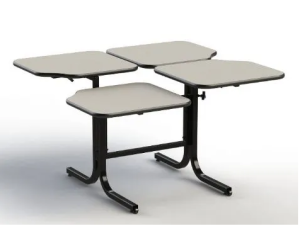8.2 Supporting Pleasurable Dining
The Physical Space

A healthcare food service dining room should account for additional physical space for adaptive devices, such as wheelchairs or walkers. There should be a minimum of fifty-two inches between tables to allow a person to sit in a wheelchair at the table. Conventional chairs should be removed from spots where a client in a wheelchair sits. There should be additional space, similar to a coat room at a restaurant, where walkers can be stored during mealtime so that they do not become trip hazards for other clients or staff.
Conventional tables may restrict movement and make clients feel uncomfortable, and an uncomfortable client will eat less. Adjustable tables will accommodate different mobility demands, providing comfort that encourages intake.
Soft, warm, or natural lighting is recommended, as the harsh glare from fluorescent lighting can cause confusion for clients with vision issues or dementia. Soft lighting creates a more home-like atmosphere in the dining room.
Studies have shown that colour affects human moods. Reds are stimulating. Exposure to red can physically raise your heart rate and initiate the fight-or-flight response. This is not an ideal choice for a dining room in which the intention is to provide a calm and relaxed environment. Yellows have been shown to energize emotions and motivate creativity. However, blues and greens have been shown to provide a sense of calmness that supports intellectual thought and conversation (Wei et al., 2023). As stated in the studies, “blue has a universal meaning and that people seldom feel negative emotions about this colour, blue conveys credibility, high quality, relaxation, tranquility, coolness and cheerfulness” (Wei, et al., 2023, para. 4). Blue seems to be a good choice for a dining room.

Many people find that a dining room with lots of loud background noise can negatively impact the dining experience. Music can be a tactic used to reduce the amount of noise from the clicking of plates, the sound of equipment moving, and staff chatter. Some people enjoy music while they eat; others do not. This is an area where individual perception and opinion should be taken into consideration before deciding on music or no music.
Setting the table with contrasting colours, for example, white tablecloths and blue plates, helps those with vision issues to eat independently. Setting the table with adaptive cutlery and dishware can allow others to eat independently. There are many types of adaptive cutlery, such as thicker, contoured, lighter, different shapes, and materials. These adaptations can help those having difficulties with mobility and dexterity maintain their independence when dining. For example, a palm grip is a strap which goes around the hand and holds the cutlery can help people who cannot grip an item of cutlery (Nightingale Hammerson, n.d.A). Dishware can also be adapted. For example, plate guards, lipped plates, and suction bowls help with scooping food (Nightingale Hammerson, n.d.B).

The Clients

Engage the clients by hosting a residents’ food committee. This monthly meeting can be an opportunity to discuss menus that reflect current clients’ social, ethnic, and religious practices and needs. Special occasion menus, such as Canada Day, can also be discussed at this meeting. Providing special occasion menus and themed meals can bring a sense of positivity and joy to the dining experience. By respecting choices and personalizing menus whenever possible, the food service team is demonstrating that they care about their clients’ dining experience.
Staff Education
The level of cleanliness will affect the dining experience and resident food intake. Educate the staff on how important proper cleaning and sanitation are to the dining experience. How the staff interact and treat the clients will also have an impact on how much people eat and whether or not they enjoy mealtime. Customer service training is essential for staff. If you work in a facility with clients who have medical conditions, such as dementia, it is valuable to provide staff with knowledge of dementia care. The level of care demonstrated by staff correlates with positive health outcomes for clients.
Quality nutrition, hydration, and pleasurable dining enhance the quality of life and quality of care that clients receive in the facility (Dietitians of Canada, 2019).

